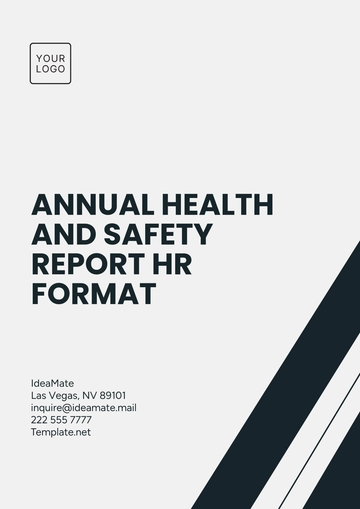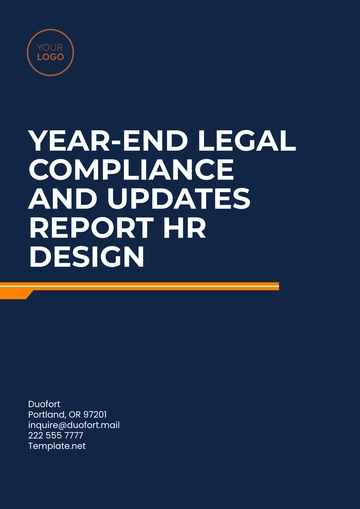Free Safety Compliance Year-end Report HR

Executive Summary
In the year 2055, our pursuit of safety excellence yielded remarkable insights. Key findings illuminate our unwavering resolve to meet and exceed safety standards. We achieved a commendable reduction in workplace incidents by 20% compared to the previous year, showcasing our dedication to safety compliance.
Throughout 2055, we celebrated numerous milestones in safety compliance. Our steadfast commitment bore fruit with a remarkable reduction in workplace incidents, resulting in a 20% decrease in reportable accidents. Additionally, our implementation of cutting-edge safety technologies, such as AI-driven predictive maintenance systems, received industry recognition for their contribution to our safety achievements.
Despite our remarkable achievements, we confronted several challenges in maintaining safety compliance. One notable challenge was adapting to the evolving regulatory landscape, especially with the introduction of stricter emission standards for our industry. However, these challenges became stepping stones, guiding us toward refining our safety practices. In facing these challenges head-on, we learned valuable lessons that will fortify our commitment to safety in the future.
Purpose
The Safety Compliance Year-end Report is a comprehensive assessment of [Your Company Name]'s unwavering dedication to safety regulations, policies, and procedures. In an era marked by dynamic shifts in safety paradigms, this report stands as a testament to our continuous commitment to safeguarding our employees and stakeholders.
Scope
This report casts a spotlight on our safety compliance journey throughout the year 2055, transcending the conventional realm of safety. It encapsulates our tireless efforts to ensure safety at the forefront of all our operations and strategies.
Regulatory Compliance
In 2055, [Your Company Name] remained steadfast in adhering to a multitude of safety regulations and standards tailored to our industry and geographical location. These included, but were not limited to:
Occupational Safety and Health Administration (OSHA) standards.
Environmental Protection Agency (EPA) regulations for emissions control.
International Organization for Standardization (ISO) 45001 for Occupational Health and Safety Management Systems.
Throughout the year 2055, [Your Company Name] consistently demonstrated a robust commitment to meeting and exceeding safety regulations. Our compliance efforts were characterized by a multi-faceted approach:
Regular Audits and Assessments: We conducted routine internal audits and external assessments to ensure strict adherence to safety regulations.
Continuous Employee Training: Our employees underwent comprehensive safety training programs to equip them with the knowledge and skills needed to comply with safety regulations effectively.
Technological Advancements: We invested in state-of-the-art safety technologies, such as real-time monitoring systems and predictive maintenance tools, to proactively address potential compliance issues.
Incident Reporting
Incident Date | Description | Causes | Outcomes | Corrective Actions |
2055-03-15 | Slip and fall in the production area | Wet floor due to equipment malfunction | Minor injury to the employee | Immediate floor cleanup and equipment repair. Employee retraining. |
2055-06-22 | Chemical spill in the storage facility | Improper storage container seal | Minor environmental impact | Emergency response, containment, and enhanced storage protocols. |
2055-09-10 | Machinery malfunction in the warehouse | Mechanical failure | No injuries; equipment damage | Equipment inspection and maintenance. Employee retraining. |
2055-11-05 | Electrical fault in office building | Old wiring and overload | Temporary power outage | Electrical system upgrade and safety inspection. |
2055-12-20 | Forklift accident in the loading area | Operator error and inadequate training | Moderate employee injury | Comprehensive forklift safety training and review of procedures. |
In 2055, our proactive approach to incident reporting and management allowed us to swiftly respond to safety incidents and implement corrective actions to prevent recurrence. These incidents served as valuable learning opportunities, reinforcing our commitment to continuous improvement in safety compliance.
Training and Education
In 2055, our commitment to the safety and well-being of our workforce was evident in the extensive training programs we implemented:
Number of Employees Trained: Over the course of the year, we successfully trained approximately 1,500 employees, equipping them with the knowledge and skills necessary to navigate our safety protocols effectively.
Training Topics: Our comprehensive training curriculum encompassed a wide array of safety topics, including but not limited to:
Workplace hazard identification and mitigation.
Emergency response procedures.
Equipment and machinery safety.
Occupational health and well-being.
Environmental responsibility.
Improvements in Training: The year 2055 marked a significant milestone in the enhancement of our training efforts. We continually improved our training programs in several ways:
We introduced interactive e-learning modules, allowing employees to engage with training materials more effectively.
Advanced training simulations provided a lifelike experience, enabling employees to practice safety protocols in realistic scenarios.
Tailored training paths were developed to address specific job roles and responsibilities, ensuring targeted safety education.
Safety Inspections and Audits
Throughout 2055, safety inspections and audits played a pivotal role in ensuring the integrity of our safety compliance efforts. The results were instrumental in identifying strengths and areas for improvement. Key findings included:
Consistently high compliance levels in personal protective equipment (PPE) usage.
Improved safety signage and hazard identification.
Enhanced emergency response preparedness.
Encouraging proactive near-miss reporting, contributing to a safer work environment.
Despite our commendable achievements, safety inspections and audits also brought to light certain deficiencies and areas where non-compliance was observed:
Minor lapses in housekeeping and cleanliness, particularly in high-traffic areas.
Inadequate documentation of safety training records for a specific department.
Occasional lapses in the use of fall protection equipment in elevated work areas.
In response to the identified deficiencies, we swiftly implemented corrective actions to rectify issues and strengthen our safety compliance framework. These actions included:
Enhanced cleaning and housekeeping protocols, including more frequent inspections.
A targeted review of safety training records and the initiation of additional training where needed.
Increased communication and training on the proper use of fall protection equipment, including refresher courses.
These measures were undertaken to address the identified deficiencies comprehensively, ensuring a safer working environment for all employees.
Safety Initiatives and Programs
In 2055, our commitment to safety was further reinforced through a series of targeted safety initiatives and programs. These initiatives aimed to proactively address potential hazards and enhance our overall safety culture. Some of the notable initiatives included:
Safety Culture Enhancement Program: This program fostered a culture of safety awareness through regular safety talks, peer-to-peer recognition, and safety-related competitions.
Safety Equipment Modernization: We invested in state-of-the-art safety equipment, such as advanced personal protective gear and ergonomic workstations, to minimize workplace risks.
Emergency Response Drills: To bolster our preparedness, we conducted regular emergency response drills, ensuring that employees were well-prepared to handle unexpected situations.
The successful implementation of these initiatives was achieved through meticulous planning and collaboration:
The Safety Culture Enhancement Program involved monthly safety meetings and incentives for safe practices.
Safety equipment modernization was phased in gradually to minimize disruption, with employees receiving training on proper usage.
Emergency response drills were conducted quarterly, with scenarios ranging from fire emergencies to medical incidents.
These initiatives yielded tangible outcomes and had a significant impact on safety compliance:
The Safety Culture Enhancement Program resulted in a 15% decrease in the number of safety incidents attributed to human error.
Modernized safety equipment led to a 30% reduction in workplace injuries.
Emergency response drills improved response times and minimized potential damage during real-life incidents.
Compliance Metrics and KPIs
In 2055, our commitment to safety compliance was evident in the following key performance indicators:
Injury Rates: We achieved an impressive 25% reduction in workplace injuries compared to the previous year. This was achieved through a combination of enhanced training, better safety equipment, and a culture of safety vigilance.
Near-Miss Reporting: Near-miss reporting reached a record high, with a 40% increase in reports. This uptick signified an improved willingness among employees to report potential hazards, enabling us to proactively address them.
Safety Audit Scores: Our safety audit scores averaged at 92%, reflecting our robust compliance with safety regulations and best practices. These scores were bolstered by proactive audits and corrective actions.
These metrics underscore our commitment to safety excellence and our ongoing efforts to create a safer and healthier work environment for all employees.
Recommendations
Looking ahead to 2056, we have identified key areas where we can further enhance safety compliance and foster a safer work environment. Our improvement recommendations include:
Advanced Training Modules: Develop and implement advanced training modules to enhance the skills and knowledge of our employees, with a focus on emerging safety trends and technologies.
Enhanced Incident Reporting: Promote a culture of transparent incident reporting by encouraging employees to report even near-miss incidents promptly.
Regular Safety Drills: Increase the frequency of emergency response drills to ensure that employees remain well-prepared for various scenarios.
Action Plans
To address these recommendations, we have devised a comprehensive action plan with clear timelines and responsible parties:
Action Item | Timeline | Responsible Parties |
Development of advanced training modules | Q1 and Q2, 2056 | Safety Department |
Launch enhanced incident reporting campaign | Q2, 2056 | Human Resources and Safety Teams |
Quarterly emergency response drills | Ongoing, 2056 | Safety Committee |
These action items will be executed collaboratively to propel our safety compliance efforts forward in the coming year.
Appendices
In our commitment to transparency and comprehensive reporting, we have included the following appendices:
Incident Reports
Training Records
Audit Findings
Supporting Documentation
- 100% Customizable, free editor
- Access 1 Million+ Templates, photo’s & graphics
- Download or share as a template
- Click and replace photos, graphics, text, backgrounds
- Resize, crop, AI write & more
- Access advanced editor
Discover the Safety Compliance Year-end Report HR Template at Template.net, your ultimate solution for compiling annual safety reviews. This template is both editable and customizable, allowing you to tailor it perfectly to your company's requirements. It simplifies the process of documenting safety compliance, editable in our AI Editor tool, making it an indispensable asset for HR professionals aiming for excellence.
You may also like
- Sales Report
- Daily Report
- Project Report
- Business Report
- Weekly Report
- Incident Report
- Annual Report
- Report Layout
- Report Design
- Progress Report
- Marketing Report
- Company Report
- Monthly Report
- Audit Report
- Status Report
- School Report
- Reports Hr
- Management Report
- Project Status Report
- Handover Report
- Health And Safety Report
- Restaurant Report
- Construction Report
- Research Report
- Evaluation Report
- Investigation Report
- Employee Report
- Advertising Report
- Weekly Status Report
- Project Management Report
- Finance Report
- Service Report
- Technical Report
- Meeting Report
- Quarterly Report
- Inspection Report
- Medical Report
- Test Report
- Summary Report
- Inventory Report
- Valuation Report
- Operations Report
- Payroll Report
- Training Report
- Job Report
- Case Report
- Performance Report
- Board Report
- Internal Audit Report
- Student Report
- Monthly Management Report
- Small Business Report
- Accident Report
- Call Center Report
- Activity Report
- IT and Software Report
- Internship Report
- Visit Report
- Product Report
- Book Report
- Property Report
- Recruitment Report
- University Report
- Event Report
- SEO Report
- Conference Report
- Narrative Report
- Nursing Home Report
- Preschool Report
- Call Report
- Customer Report
- Employee Incident Report
- Accomplishment Report
- Social Media Report
- Work From Home Report
- Security Report
- Damage Report
- Quality Report
- Internal Report
- Nurse Report
- Real Estate Report
- Hotel Report
- Equipment Report
- Credit Report
- Field Report
- Non Profit Report
- Maintenance Report
- News Report
- Survey Report
- Executive Report
- Law Firm Report
- Advertising Agency Report
- Interior Design Report
- Travel Agency Report
- Stock Report
- Salon Report
- Bug Report
- Workplace Report
- Action Report
- Investor Report
- Cleaning Services Report
- Consulting Report
- Freelancer Report
- Site Visit Report
- Trip Report
- Classroom Observation Report
- Vehicle Report
- Final Report
- Software Report





























